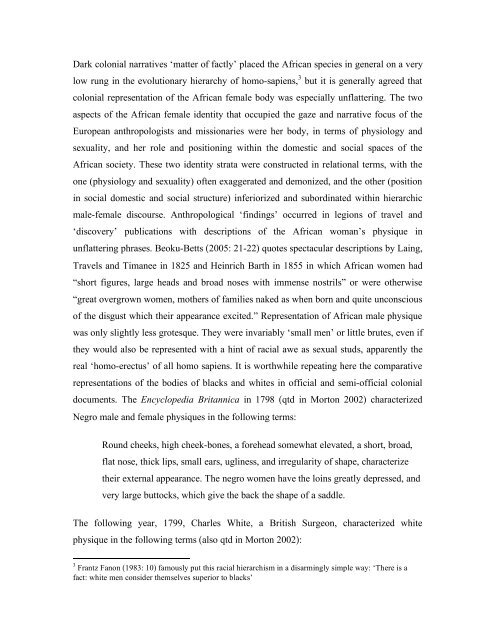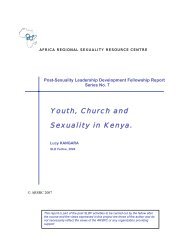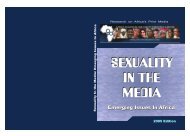body images beauty culture and language - Africa Regional ...
body images beauty culture and language - Africa Regional ...
body images beauty culture and language - Africa Regional ...
Create successful ePaper yourself
Turn your PDF publications into a flip-book with our unique Google optimized e-Paper software.
Dark colonial narratives ‘matter of factly’ placed the <strong>Africa</strong>n species in general on a very<br />
low rung in the evolutionary hierarchy of homo-sapiens, 3 but it is generally agreed that<br />
colonial representation of the <strong>Africa</strong>n female <strong>body</strong> was especially unflattering. The two<br />
aspects of the <strong>Africa</strong>n female identity that occupied the gaze <strong>and</strong> narrative focus of the<br />
European anthropologists <strong>and</strong> missionaries were her <strong>body</strong>, in terms of physiology <strong>and</strong><br />
sexuality, <strong>and</strong> her role <strong>and</strong> positioning within the domestic <strong>and</strong> social spaces of the<br />
<strong>Africa</strong>n society. These two identity strata were constructed in relational terms, with the<br />
one (physiology <strong>and</strong> sexuality) often exaggerated <strong>and</strong> demonized, <strong>and</strong> the other (position<br />
in social domestic <strong>and</strong> social structure) inferiorized <strong>and</strong> subordinated within hierarchic<br />
male-female discourse. Anthropological ‘findings’ occurred in legions of travel <strong>and</strong><br />
‘discovery’ publications with descriptions of the <strong>Africa</strong>n woman’s physique in<br />
unflattering phrases. Beoku-Betts (2005: 21-22) quotes spectacular descriptions by Laing,<br />
Travels <strong>and</strong> Timanee in 1825 <strong>and</strong> Heinrich Barth in 1855 in which <strong>Africa</strong>n women had<br />
“short figures, large heads <strong>and</strong> broad noses with immense nostrils” or were otherwise<br />
“great overgrown women, mothers of families naked as when born <strong>and</strong> quite unconscious<br />
of the disgust which their appearance excited.” Representation of <strong>Africa</strong>n male physique<br />
was only slightly less grotesque. They were invariably ‘small men’ or little brutes, even if<br />
they would also be represented with a hint of racial awe as sexual studs, apparently the<br />
real ‘homo-erectus’ of all homo sapiens. It is worthwhile repeating here the comparative<br />
representations of the bodies of blacks <strong>and</strong> whites in official <strong>and</strong> semi-official colonial<br />
documents. The Encyclopedia Britannica in 1798 (qtd in Morton 2002) characterized<br />
Negro male <strong>and</strong> female physiques in the following terms:<br />
Round cheeks, high cheek-bones, a forehead somewhat elevated, a short, broad,<br />
flat nose, thick lips, small ears, ugliness, <strong>and</strong> irregularity of shape, characterize<br />
their external appearance. The negro women have the loins greatly depressed, <strong>and</strong><br />
very large buttocks, which give the back the shape of a saddle.<br />
The following year, 1799, Charles White, a British Surgeon, characterized white<br />
physique in the following terms (also qtd in Morton 2002):<br />
3 Frantz Fanon (1983: 10) famously put this racial hierarchism in a disarmingly simple way: ‘There is a<br />
fact: white men consider themselves superior to blacks’






